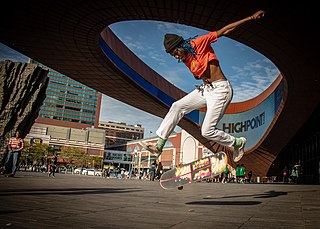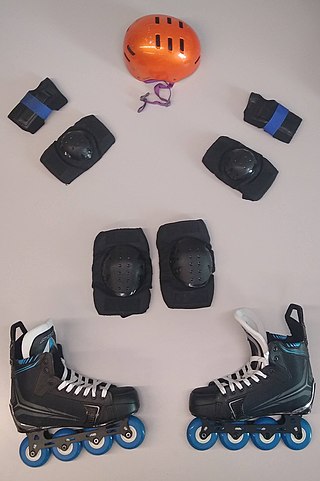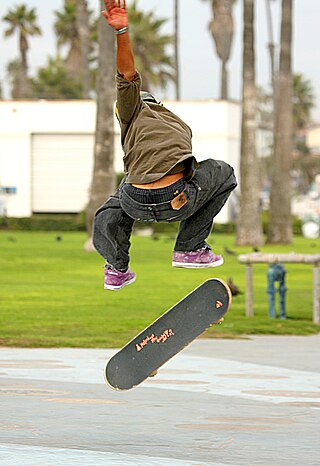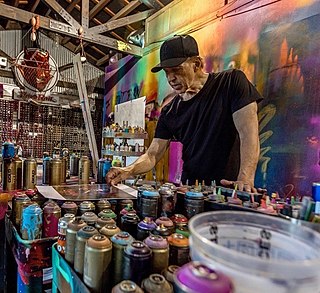Related Research Articles

Skateboarding is an action sport that involves riding and performing tricks using a skateboard, as well as a recreational activity, an art form, an entertainment industry job, and a method of transportation. Originating in the United States, skateboarding has been shaped and influenced by many skateboarders throughout the years. A 2009 report found that the skateboarding market is worth an estimated $4.8 billion in annual revenue, with 11.08 million active skateboarders in the world. In 2016, it was announced that skateboarding would be represented at the 2020 Summer Olympics in Tokyo, for both male and female teams. Skateboarding made its Olympic debut in 2020 and is included in the 2024 games.

Inline skates are a type of roller skate used for inline skating. Unlike typical roller skates, which have two front and two rear wheels, inline skates typically have two to five wheels arranged in a single line. Some, especially those for recreation, have a rubber "stop" or "brake" block attached to the rear of one or occasionally both of the skates so that the skater can slow down or stop by leaning back on the foot with the brake skate.

Roller skating is the act of travelling on surfaces with roller skates. It is a recreational activity, a sport, and a form of transportation. Roller rinks and skate parks are built for roller skating, though it also takes place on streets, sidewalks, and bike paths.

Inline skating is a multi-disciplinary sport and can refer to a number of activities practiced using inline skates. Inline skates typically have two to five polyurethane wheels depending on the style of practice, arranged in a single line by a metal or plastic frame on the underside of a boot. The in-line design allows for greater speed and maneuverability than traditional roller skates. Following this basic design principle, inline skates can be modified to varying degrees to accommodate niche disciplines.

A longboard is a type of skateboard typified by longer decks and wheelbases, larger-diameter and softer (lower-durometer) wheels, and often lower riding height compared to street skateboards, though there is wide variation in the geometry and construction of longboards. Among the earliest types of skateboards, longboards were inspired by surfing, with early longboards drawing from the design of surfboards, resembling and mimicking the motion of riding a surfboard, but adapted to riding on streets in a practice known as sidewalk surfing.

Longboarding is a variation of skateboarding typified by the use of longer boards ("decks") with longer wheelbases and softer wheels. While longboards vary widely in shape and size, compared to street skateboards longboards are designed to be more stable at speed and to have more traction due to larger wheel sizes and softer wheel durometers. While standard street skateboards may typically be between 28 and 34 inches long, longboards can range anywhere from 32 to 50 inches in length. Ride characteristics of longboards generally differ from that of street skateboards due to the use of specialized longboard trucks that have different properties than those typically used with skateboards; while street skateboards use "traditional kingpin" (TKP) trucks that are optimized for tight turning radii, ollie and flip tricks, slides, grinds, and transition skating, longboards are typically paired with "reverse kingpin" (RKP) trucks that are designed for increased stability at higher speeds, more "surfy" carving characteristics, and/or greater ride comfort for commuting over longer distances.

Powell Peralta is an American skateboard company founded by George Powell and Stacy Peralta in 1978. The company rose to prominence in the 1980s as skateboarding began maturing as a sport. The company featured the Bones Brigade, a team featuring the era's top competitors. Peralta left the company in 1991 and Powell continued to produce skateboard equipment as Powell, Bones Bearings and RollerBones. The two company founders reunited to produce the company's now classic inventory under the name Powell Classic.

Jay J. Adams was an American skateboarder. As a teen, he was the youngest member of the Zephyr Competition Skateboarding Team (Z-Boys). His spontaneous freestyle skateboarding style, inspired by ocean surfing, helped innovate and popularize modern skateboarding. His aggressive vertical tricks make him one of skateboarding's most influential stylists. He has been called "the original seed" of skateboarding.
The Zephyr Competition Team were a group of American skateboarders in the mid-1970s from Santa Monica and Venice, California. Originally consisting of 12 members, the Z-boys were originally sponsored by the Jeff Ho Surfboards and Zephyr Productions surf and skate shop. Their innovative surfing-based style and aerial moves formed the foundations of contemporary vert and transition skateboarding. The story of the Z-Boys and the Zephyr shop have been popularized in feature films such as Lords of Dogtown and Dogtown and Z-Boys.
Artistic roller skating is a competitive sport similar to figure skating but where competitors wear roller skates instead of ice skates. Within artistic roller skating, there are several disciplines:
Gregg Weaver is a skateboarder who was a part of San Diego's famed skate scene and one of skateboarding's early superstars. During the resurgence of skateboarding in the early to mid-1970s, he was one of the most heavily photographed riders being a favorite subject of both Warren Bolster and Art Brewer.
Russell Wayne Howell is a professional skateboarder. While working towards his degree in physical education, Howell competed and won many freestyle skateboarding competitions throughout his skating career.
Ty Scott Page was a professional skateboarder and a leader in the skateboarding scene during "the golden era" of skateboarding in the early 1970s.

A skateboard is a type of sports equipment used for skateboarding. It is usually made of a specially designed 7–8-ply maple plywood deck and has polyurethane wheels attached to the underside by a pair of skateboarding trucks.
A fingerboard is a scaled-down replica of a skateboard that a person "rides" with their fingers, rather than their feet. A fingerboard is typically 100 millimeters (3.9 in) long with width ranging from 26 to 55 mm, with graphics, trucks and plastic or ball-bearing wheels, like a skateboard. A fingerboard can be used to do traditional skateboarding tricks, such as an ollie and kickflip.

On a roller coaster, the wheel assemblies are the point of contact between the cars carrying the riders and the track rails. They often consist of at least 3 wheels per assembly, but can contain more.

Jim Evans, sometimes known as TAZ, is an American painter, printmaker, and creative director who was a contributing figure in the visual art movement known as underground comix. After success as an illustrator of Underground Comix, Evans became known for his Album Cover and Film Poster art and hundreds of Rock Music posters, in addition to being owner of the Digital Marketing group, Division 13.

Street skateboarding is a skateboarding discipline which focuses on flat-ground tricks, grinds, slides and aerials within urban environments, and public spaces. Street skateboarders meet, skate, and hang out in and around urban areas referred to as "spots," which are commonly streets, plazas or industrial areas. To add variety and complexity to street skateboarding, obstacles such as handrails, stairs, walls, flower beds, bins, park benches, picnic tables, and other street furniture may be traversed as single tricks or as part of a series of consecutive tricks called a "line."

Shark Wheel is a company based in Lake Forest, California that manufactures helical wheels of the same name. Rather than a traditional circular shape, the Shark Wheel is composed of one or many three-dimensional sine waves. The shape is a hybrid of a sphere and cube, taking on the properties of both shapes while in motion. It has been touted as the reinvention of the wheel by various news outlets. The wheels were funded by a Kickstarter campaign that reached nearly eight times its initial goal. It attracted the attention of award-winning skateboarder Tony Hawk and was used by skateboarders who placed in various competitions around the world. The product appeared on ABC's Shark Tank in May 2015.

Lonnie Toft is a 1970s era American professional skateboarder and snowboarder from Southern California who has also been extensively involved with surfing, wakeboarding and standup paddleboarding. He was one of the first skateboarders to ride a broader, almost shoe-width boards. He is the inventor of the eight-wheeled skateboard and along with Gordy Lienemann created the G-turn maneuver. He is also the co-creator of the snowboard and was subsequently one of the first professional skateboarders to embrace and promote snowboarding.
References
- Weiss, Eric M., (August 17, 2004) Frank Nasworthy
Iain Borden, Skateboarding and the city: a complete history, London ; New York, Bloomsbury Academic, 2019.